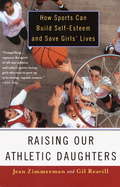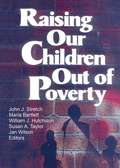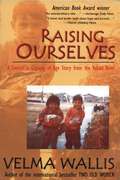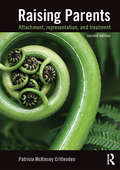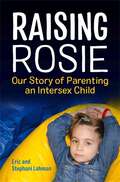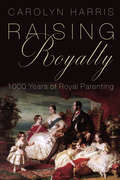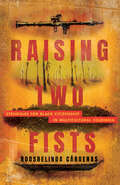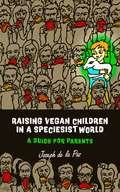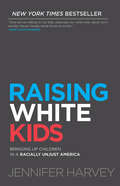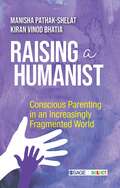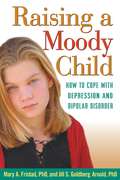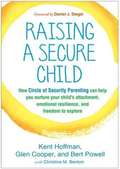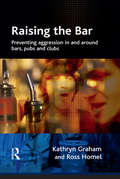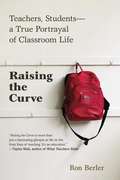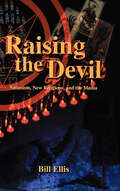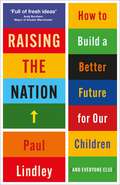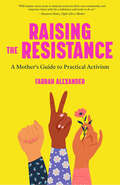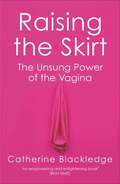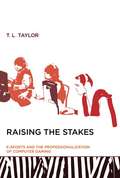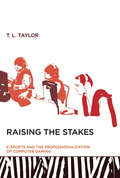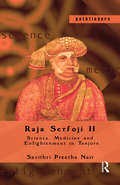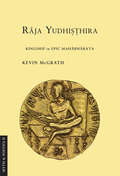- Table View
- List View
Raising Ollie: How My Nonbinary Art-Nerd Kid Changed (Nearly) Everything I Know
by Tom RademacherThe account of one radically new school year for a Teacher of the Year and for his nonbinary, art-obsessed, brilliant child Seven-year-old Ollie was researching local advanced school programs—because every second grader does that, right? Ollie, who used to hate weekends because they meant no school, was crying on the way to school almost every day. Sure, there were the slings and arrows of bullies and bad teachers, but, maybe worse, Ollie, a funny, anxious, smart kid with a thing for choir and an eye for graphic art, was gravely underchallenged and also struggling with identity and how to live totally as themselves. Ollie begged to switch to a new school with &“kids like me,&” where they wouldn&’t feel so alone, or so bored, and so they made the change. Raising Ollie is dad Tom Rademacher&’s story (really, many stories) of that eventful and sometimes painful school year, parenting Ollie and relearning every day what it means to be a father and teacher. As Ollie—who is nonbinary and uses they/them pronouns, and prefers art to athletics, vegetables to cake, and animals to most humans—flourishes in their new school, Rademacher is making an eye-opening adjustment to a new school of his own, one that&’s whiter and more suburban than anywhere he has previously taught, with a history of racial tension that he tries to address and navigate. While Ollie is learning to code, 3D model, animate, speak Japanese, and finally feel comfortable at school, Rademacher increasingly sees how his own educational struggles, anxieties, and childhood upbringing are reflected in his teaching, writing, and parenting, as well as in Ollie&’s experience. And with this story of one anything-but-academic year of inquiry and wonder, doubt and revelation, he shows us how raising a kid changes everything—and how much raising a kid like Ollie can teach us about who we are and what we&’re doing in the world.
Raising Our Athletic Daughters: How Sports Can Build Self-esteem and Save Girls' Lives
by Jean ZimmermanThe first book to document how participating in sports changes young girls' lives during the difficult years of adolescence. From high-profile women's professional leagues to high-school-level champions, girl athletes are achieving record breakthroughs. Witness, for example, the first spectacular season of the WNBA, or the celebrated victories of women's teams at the 1996 Olympics. The female athlete is a new media darling especially beloved of today's teenage girls, who are almost as likely to have pictures of Rebecca Lobo, Mia Hamm, or Gabrielle Reece on their walls as posters of Leonardo DiCaprio.So it seems paradoxical that many books and studies attest to a truly sobering picture of girls' lives. With her book Reviving Ophelia, Mary Pipher was only the latest in a string of theorists to describe the dramatic ways in which girls loose self-esteem during the critical years of adolescence, contributing to eating disorders, drug problems, and chronic depression in many young women. In Raising Our Athletic Daughters, journalists Zimmerman and Reavill set out to talk with girls and their parents about how sports can transform girls' lives. Here are firsthand stories from the inner cities and rural playing fields across the nation, offering compelling evidence that participation in athletics makes an extraordinary difference in the lives of young girls, from reducing pregnancy rates and substance abuse to increasing college attendance. Raising Our Athletic Daughters is a clarion call for all those eager to help their children succeed and level the playing field, at last.
Raising Our Children Out of Poverty
by Jan Wilson William J Hutchison John J Stretch Maria Bartlett Susan A TaylorRaising Our Children Out of Poverty shows what can be done at the national and local community levels to raise children out of poverty by strengthening families, communities, and social services. br>Based on the April 1998 symposium “Raising Our Children Out of Poverty” at the Saint Louis University School of Social Service, this important book is particularly timely given the prevalence of poverty among children in the United States. Social Work practitioners and other helping advocates will discover chapters discussing the future of foster care, ecumenical housing, collaborative practice in low income communities, fostering resiliency in children, programs that are alternatives to incarceration, and an innovative family support and empowerment program. This important book will help you provide improved services to families and children living in poverty.
Raising Ourselves: A Gwich'in Coming Of Age Story From The Yukon River
by Velma WallisBorn in 1960, the sixth of thirteen children, Velma Wallis comes of age in a two-room log cabin in remote Fort Yukon, Alaska. Life is defined by the business of living off the land. Chopping wood. Hauling water from the river. Hunting moose. Catching salmon. Traping fur. Taking care of the dogs. For a thousand years, the Gwich'in clan had followed migratory animals across the north. But two generations before, the people had settled where the Porcupine River flows into the Yukon. Now, the Wallis family has a post office box and an account at the general store, and Velma listens to Wolf Man Jack on armed forces radio. The author discovers that her people have surrendered their language, traditional values, and religion to white teachers, traders, and missionaries. Flu epidemics have claimed many loved ones. Village elders seem like strangers from another land, and in a way they are. There is much drinking when the monthly government checks come, and that is when the pain comes out of hiding. RAISING OURSELVES is a gritty, sobering, yet irresistible story filled with laughter even as generations of Gwich'in grief seeps from past to present. But hope pushes back hopelessness, and a new strength and wisdom emerge.
Raising Parents: Attachment, Representation, and Treatment
by Patricia M. CrittendenHelping troubled parents to raise their children adequately is of crucial importance for parents, their children and society at large. Distressed parents have themselves often been endangered and, as a consequence, sometimes endanger their children either through maltreatment or through the effects of parental psychiatric disorder. Raising Parents explains how that happens and clusters parents in terms of the psychological processes that result in maladaptive childrearing. The book then delineates DMM Integrative Treatment in terms of assessment, formulation, and treatment. New formulations are offered for problems that have resisted treatment and cases demonstrate how the ideas can be applied in real treatment settings. The book closes with 10 suggestions for improving professionals’ responses to troubled families and endangered children. This edition of Raising Parents introduces DMM Integrative Treatment and demonstrates how to use it with vulnerable families. DMM Integrative Treatment is an interpersonal process and this book will be essential reading for clinicians from all disciplines, including psychiatry and psychology, social work, nursing and all types of psychotherapy.
Raising Rosie: Our Story of Parenting an Intersex Child
by Georgiann Davis Stephani Lohman Eric LohmanWhen their daughter Rosie was born, Eric and Stephani Lohman found themselves thrust into a situation they were not prepared for. Born intersex - a term that describes people who are born with a variety of physical characteristics that do not fit neatly into traditional conceptions about male and female bodies - Rosie's parents were pressured to consent to normalizing surgery on Rosie, without being offered any alternatives despite their concerns. <P><P> Part memoir, part guidebook, this powerful book tells the authors' experience of refusing to have Rosie operated on and how they raised a child who is intersex. The book looks at how they spoke about the condition to friends and family, to Rosie's teachers and caregivers, and shows how they plan on explaining it to Rosie when she is older. This uplifting and empowering story is a must read for all parents of intersex children.
Raising Royalty: 1000 Years of Royal Parenting
by Carolyn HarrisHow royal parents dealt with raising their children over the past thousand years, from keeping Vikings at bay to fending off paparazzi. William and Kate, the Duke and Duchess of Cambridge, are setting trends for millions of parents around the world. The upbringing of their children, Prince George and Princess Charlotte, is the focus of intense popular scrutiny. Royalty have always raised their children in the public eye and attracted praise or criticism according to parenting standards of their day. Royal parents have faced unique challenges and held unique privileges. In medieval times, raising an heir often meant raising a rival, and monarchs sometimes faced their grown children on the battlefield. Conversely, kings and queens who lost their thrones in wars or popular revolutions often found solace in time spent with their children. In modern times, royal duties and overseas tours have often separated young princes and princesses from their parents, a circumstance that is slowly changing with the current generation of royalty.
Raising Two Fists: Struggles for Black Citizenship in Multicultural Colombia
by Roosbelinda CárdenasRaising Two Fists is a historically grounded ethnography of Afro-Colombian political mobilization after the multicultural turn that swept Latin America in the 1990s, when states began to recognize and legally enshrine rights for Afro-descendants. Roosbelinda Cárdenas explores three major strategies that Afro-Colombians' developed in their struggles against racialized dispossession—the defense of culturally specific livelihoods through the creation of Black Territories; the demand for differential reparations for Afro-Colombian war victims; and the fight for inclusion in Colombia's peace negotiations and post-conflict rebuilding—illustrating how they engage in this work both as participants of organized political movements and in their everyday lives. Although rights-based claims to the state have become necessary and pragmatic tools in the intersecting struggles for racial, economic, and social justice, Cárdenas argues that they continue to be ineffective due to Colombia's entrenched colonial racial hierarchies. She shows that while Afro-Colombians pursue rights-based claims, they also forge African Diasporic solidarities and protect the flourishing of their lives outside of the frame of rights, and with or without the state's sanction—a "two-fisted" strategy for Black citizenship.
Raising Vegan Children in a Speciesist World: A Guide for Parents
by Joseph de la Paz"When you rock your baby, you truly hold the future of humanity in your hands." This book is a practical guide for parents who have embarked on the mission of raising their vegan children. It covers all different aspects involved, including: •how to start out on the right foot •how to overcome fears and doubts •how to tackle concerns around nutrition •how to explain veganism to children •how to deal with the difficult situations that may arise both in and outside of the home •useful resources
Raising White Kids: Bringing Up Children in a Racially Unjust America
by Jennifer HarveyThis New York Times best-selling book is a guide for families, educators, and communities to raise their children to be able and active anti-racist allies.With a foreword by Tim Wise, Raising White Kids is for families, churches, educators, and communities who want to equip their children to be active and able participants in a society that is becoming one of the most racially diverse in the world while remaining full of racial tensions. For white people who are committed to equity and justice, living in a nation that remains racially unjust and deeply segregated creates unique conundrums.These conundrums begin early in life and impact the racial development of white children in powerful ways. What can we do within our homes, communities and schools? Should we teach our children to be "colorblind"? Or, should we teach them to notice race? What roles do we want to equip them to play in addressing racism when they encounter it? What strategies will help our children learn to function well in a diverse nation?Talking about race means naming the reality of white privilege and hierarchy. How do we talk about race honestly, then, without making our children feel bad about being white? Most importantly, how do we do any of this in age-appropriate ways?While a great deal of public discussion exists in regard to the impact of race and racism on children of color, meaningful dialogue about and resources for understanding the impact of race on white children are woefully absent. Raising White Kids steps into that void."Most white Americans didn't get from our own families the concrete teaching and modeling we needed to be active in the work of racial justice ourselves, let alone to feel equipped now to talk about race with and teach anti-racism to our children. There is so much we need to learn and it's urgent that we do so. But the good news is: we can," says Jennifer Harvey.
Raising a Humanist: Conscious Parenting in an Increasingly Fragmented World
by Manisha Pathak- Shelat Kiran BhatiaThe world is immensely divided and broken. We have lost the art of having conversations with those who are different from us. While we cannot change the world, we can take small remedial steps starting with our homes and communities. The authors—communication scholars—with a vast experience of working with parents, teachers and youth engage you in a conversation that is bound to leave a lasting impression on you, your children, and our world. Using critical questions, pragmatic tips and interesting anecdotes, they touch upon the deep divisive issues of our society and provide fascinating ways to use art, technology and media to provide our children with a nurturing community. Bold and provocative at times, this empowering book is your companion in raising a humanist.
Raising a Moody Child
by Mary S. Arnold Mary A. FristadEvery day can be an ordeal for families struggling with the difficult, moody, "impossible" behavior that may point to childhood depression or bipolar disorder. Effective help for kids does exist, but it often requires a customized combination of medication, therapy, coping skills, and support. From esteemed clinician and researcher Dr. Mary Fristad and fellow treatment expert Dr. Jill Goldberg Arnold, this indispensable book explains how treatment works and what additional steps parents can take at home to help children with mood disorders--and the family as a whole--improve the quality of their lives. Explained are why symptoms look so different (and can be so much harder to manage) in children and teens than in adults, how to find the right doctor or therapist, and how to help kids develop their own "coping toolkits." Bursting with practical tools, FAQs, and examples, the book covers everything from dealing with medical crises to resolving school problems, sibling conflicts, and marital stress.
Raising a Secure Child: How Circle of Security Parenting Can Help You Nurture Your Child's Attachment, Emotional Resilience, and Freedom to Explore
by Christine M. Benton Daniel J. Siegel Glen Cooper Bert Powell Kent HoffmanToday's parents are constantly pressured to be perfect. But in striving to do everything right, we risk missing what children really need for lifelong emotional security. Now the simple, powerful "Circle of Security" parenting strategies that Kent Hoffman, Glen Cooper, and Bert Powell have taught thousands of families are available in self-help form for the first time. You will learn: *How to balance nurturing and protectiveness with promoting your child's independence. *What emotional needs a toddler or older child may be expressing through difficult behavior. *How your own upbringing affects your parenting style--and what you can do about it. Filled with vivid stories and unique practical tools, this book puts the keys to healthy attachment within everyone's reach--self-understanding, flexibility, and the willingness to make and learn from mistakes. Self-assessment checklists can be downloaded and printed for ease of use.
Raising the Bar (Crime Science Series)
by Ross Homel Kathryn GrahamThis book provides a definitive review of knowledge about bar room environments and their regulation, and provides directions for the prevention of aggression, violence and injury in and around public drinking establishments. It shows why drinking establishments are high risk for aggression, why some establishments are riskier than others, the effectiveness of existing interventions and policies, and the importance of better regulatory models for achieving safer drinking establishments. The authors emphasise the need to understand the problem and to tackle it through evidence-based preventive strategies, providing a detailed review of the nature of problem behaviours within the specific context of public drinking establishments - while recognising that these establishments are businesses that operate in diverse communities and cultures. Special attention is paid to the difficulties in implementing and sustaining effective interventions within the kinds of regulatory structures and political and economic climates that currently prevail in western countries. The book draws upon the authors' extensive experience with observational, interview and intervention research related to reducing aggression and injury in drinking establishments, as well as their knowledge of the alcohol field, and of prevention, policing and regulation more generally.
Raising the Curve
by Ron BerlerBrookside Elementary in Norwalk, Connecticut, is preparing for a new school year and another chance to improve its failing scores on the statewide standardized test known as the CMT. The challenges are many, and for the faculty--whose jobs may depend on their students' ability to improve on the test--the stakes are high. Ten-year-old Hydea is about to start fifth grade with second-grade reading skills. Her friend Marbella is only a little further along. In past years, these students would have received help from the literacy specialist Mrs. Schaefer. But this year, due to cutbacks and a change in job description, she will have to select the few students whom she and the teachers can bet on--the ones who are close to passing the exams. And, for added measure, Principal Hay has already asked his faculty to teach to the test. Journalist Ron Berler spent a full year at Brookside. In Raising the Curve, he offers a nuanced and personal portrait of the students, teachers, and staff who make up the Brookside community, capturing their struggles as well as their pride, resilience, and spirited faith.
Raising the Devil: Satanism, New Religions, and the Media
by Bill Ellis“Puts [the phenomena of Satanism] in the context of folklore and folk traditions . . . Highly recommended as a lucid and well-documented account.” —Library JournalRaising the Devil reveals how the Christian Pentecostal movement, right-wing conspiracy theories, and an opportunistic media turned grassroots folk traditions into the Satanism scare of the 1980s. During the mid-twentieth century, devil worship was seen as merely an isolated practice of medieval times. But by the early 1980s, many influential experts in clinical medicine and in law enforcement were proclaiming that satanic cults were widespread and dangerous. By examining the broader context for alleged “cult” activity, Bill Ellis demonstrates how the image of contemporary Satanism emerged. In some of the cases Ellis considers, common folk beliefs and rituals were misunderstood as evidence of devil worship. In others, narratives and rituals themselves were used to combat satanic forces. As the media found such stories attractive, any activity with even remotely occult overtones was demonized in order to fit a model of absolute good confronting evil.Ellis’s wide-ranging investigation covers ouija boards, cattle mutilation, graveyard desecration, and “diabolical medicine” —the psychiatric community’s version of exorcism. He offers a balanced view of contentious issues such as demonic possession, satanic ritual abuse, and the testimonies of confessing “ex-Satanists.” A trained folklorist, Ellis navigates a middle road, and his insights into informal religious traditions clarify how the image of Satanism both explained and created deviant behavior.“An interesting analysis of satanic folklore and organized anti-satanism in the US and UK.” —Choice“Shows how ancient bogeyman beliefs became aligned with politics and the criminal justice system to produce witch-hunts like the infamous McMartin Preschool case.” —Mother Jones
Raising the Nation: How to Build a Better Future for Our Children (and Everyone Else)
by Paul LindleyChildren today grow up in an increasingly volatile, complex and uncertain world. Theirs is a generation disempowered from steering their lives while society’s systems are failing to provide the support they need. Yet, a country only prospers when its children – from all walks of life – thrive, meaning that the United Kingdom now faces some consequential choices. Raising the Nation builds a compelling case showing why we must nurture smart, strong and kind children to one day inherit the stewardship of society. Setting out big public policy ideas, enhanced by contributions from academic and campaigning experts, as well as those with lived experience, including London Mayor Sadiq Khan, singer and activist Charlotte Church, and ex-prime minister of Denmark and former CEO of Save the Children International Helle Thorning-Schmidt, this book is a manifesto to deliver our brightest possible future. Reframing political success, it shows why we must prioritise child-centred policies to ensure the future strength of our communities, environment and economy.
Raising the Resistance: A Mother's Guide to Practical Activism
by Farrah AlexanderA sensible guide for mothers looking to incorporate activism in their parenting to raise empathetic, politically aware children.Acknowledging the dual role of mother and citizen, Scary Mommy writer and mom Farrah Alexander provides empowerment and guidance for the modern progressive mother . . .Mothers are a force to be reckoned with. And after the Women’s March and midterm elections, moms have surely secured their spot in today’s feminist movement. But for those who aren’t ready to make a bid for the presidency, the way forward can seem daunting and unclear. Whether it’s correcting a misinformed family member about gender equality or running for political office, this bold and accessible primer presents active parents with different types of activism they can incorporate into their parenting, no matter how big or small.With practical guidance, political commentary, and inspiration, this feminist manifesto for moms tackles problems from political representation to sexual misconduct. It doesn’t just validate present-day feminist frustration, it also offers practical ways to channel it into solutions. Most importantly, it proves that by planting seeds of empathy and political awareness in their children, moms can raise their children to be change-makers. They can raise the resistance.Inside, learn:Self-care techniques for badass momsStrategies for becoming a role model in today’s feminist movementDifferent types of activism moms can use to take a stand, and more!Praise for Raising the Resistance“Will inspire every mom to demand action in their own community and empower them with the confidence and tools to do so.” —Shannon Watts, author of Fight Like a Mother
Raising the Skirt: The Unsung Power of the Vagina
by Catherine Blackledge'A meticulous guide not only to the vagina but to changing perceptions of womanhood' OBSERVER'An empowering and enlightening book' IRISH TIMESThe vagina is the ultimate symbol of female power. Sexual power, creative power and the power to prevent harm. For too long, though, the true extent of vaginal power has been ignored, hidden and misrepresented. Raising the skirt: the unsung power of the vagina reveals this revolutionary view of female genitalia and points the way to a new understanding of what it means to be female. An inspiration for millennia, the vagina is actually a muscular marvel of engineering - sensitive and strong, fluid and flexible. Far from being a passive vessel, female genitalia control the most important role of all: the survival of the species.Originally published as THE STORY OF V: OPENING PANDORA'S BOX
Raising the Skirt: The Unsung Power of the Vagina
by Catherine Blackledge'A meticulous guide not only to the vagina but to changing perceptions of womanhood' OBSERVER'An empowering and enlightening book' IRISH TIMESThe vagina is the ultimate symbol of female power. Sexual power, creative power and the power to prevent harm. For too long, though, the true extent of vaginal power has been ignored, hidden and misrepresented. Raising the skirt: the unsung power of the vagina reveals this revolutionary view of female genitalia and points the way to a new understanding of what it means to be female. An inspiration for millennia, the vagina is actually a muscular marvel of engineering - sensitive and strong, fluid and flexible. Far from being a passive vessel, female genitalia control the most important role of all: the survival of the species.Originally published as THE STORY OF V: OPENING PANDORA'S BOX
Raising the Stakes
by T. L. TaylorCompetitive video and computer game play is nothing new: the documentary King of Kong memorably portrays a Donkey Kong player's attempts to achieve the all-time highest score; the television show Starcade (1982--1984) featured competitions among arcade game players; and first-person shooter games of the 1990s became multiplayer through network play. A new development in the world of digital gaming, however, is the emergence of professional computer game play, complete with star players, team owners, tournaments, sponsorships, and spectators. In Raising the Stakes, T. L. Taylor explores the emerging scene of professional computer gaming and the accompanying efforts to make a sport out of this form of play. In the course of her explorations, Taylor travels to tournaments, including the World Cyber Games Grand Finals (which considers itself the computer gaming equivalent of the Olympics), and interviews participants from players to broadcasters. She examines pro-gaming, with its highly paid players, play-by-play broadcasts, and mass audience; discusses whether or not e-sports should even be considered sports; traces the player's path from amateur to professional (and how a hobby becomes work); and describes the importance of leagues, teams, agents, organizers, referees, sponsors, and fans in shaping the structure and culture of pro-gaming. Taylor connects professional computer gaming to broader issues: our notions of play, work, and sport; the nature of spectatorship; the influence of money on sports. And she examines the ongoing struggle over the gendered construction of play through the lens of male-dominated pro-gaming. Ultimately, the evolution of professional computer gaming illuminates the contemporary struggle to convert playful passions into serious play.
Raising the Stakes: E-Sports and the Professionalization of Computer Gaming
by T. L. TaylorHow a form of play becomes a sport: players, agents, referees, leagues, tournaments, sponsorships, and spectators, and the culture of professional computer game play.Competitive video and computer game play is nothing new: the documentary King of Kong memorably portrays a Donkey Kong player's attempts to achieve the all-time highest score; the television show Starcade (1982–1984) featured competitions among arcade game players; and first-person shooter games of the 1990s became multiplayer through network play. A new development in the world of digital gaming, however, is the emergence of professional computer game play, complete with star players, team owners, tournaments, sponsorships, and spectators. In Raising the Stakes, T. L. Taylor explores the emerging scene of professional computer gaming and the accompanying efforts to make a sport out of this form of play.In the course of her explorations, Taylor travels to tournaments, including the World Cyber Games Grand Finals (which considers itself the computer gaming equivalent of the Olympics), and interviews participants from players to broadcasters. She examines pro-gaming, with its highly paid players, play-by-play broadcasts, and mass audience; discusses whether or not e-sports should even be considered sports; traces the player's path from amateur to professional (and how a hobby becomes work); and describes the importance of leagues, teams, owners, organizers, referees, sponsors, and fans in shaping the structure and culture of pro-gaming.Taylor connects professional computer gaming to broader issues: our notions of play, work, and sport; the nature of spectatorship; the influence of money on sports. And she examines the ongoing struggle over the gendered construction of play through the lens of male-dominated pro-gaming. Ultimately, the evolution of professional computer gaming illuminates the contemporary struggle to convert playful passions into serious play.
Raja Serfoji II: Science, Medicine and Enlightenment in Tanjore (Pathfinders)
by Savithri Preetha NairIn the early nineteenth century, the south Indian kingdom of Tanjore, which had come under the control of the East India Company, flourished as a ‘centre’ of enlightenment. This book traces the contours of the Tanjore enlightenment, which produced a knowledge that was at once modern and deeply rooted in the indigenous tradition. The chief protagonist of this first ever full-length study on Tanjore at the turn of the nineteenth century is Raja Serfoji II (r. 1798–1832), in whose world science and God coexisted comfortably. Tanjore at this time was a thriving contact-zone, linked to several centres through extensive local and global networks. Its court attracted a great number of visitors, including Christian missionaries, high-ranking Company officials, princely contemporaries, naturalists, and medical practitioners. Dwelling on the locatedness of science and enlightenment modernity in the context of the colonial periphery, the book describes how the Raja deployed certain ‘vectors of assemblage’ — an array of practices, instruments, theories and people, including his vast collection of manuscripts, books and scientific instruments, a Devanagari printing press, a menagerie, health establishments and a large retinue of trained experts and artists — to invent Tanjore as a contemporary ‘centre’. Shunning reductionist and diffusionist explanations of the transmission of Western science in colonial settings, the study uses hitherto unexplored archival sources to reconstruct the Tanjore enlightenment as the outcome of globally situated cross-cultural exchanges. It celebrates the openness and confidence with which European science was engaged with, assimilated, translated and reinvented in a ‘contact-zone’ located in the colonial backwaters of south India. The book will be of interest to historians, sociologists and those interested in history of science and medicine, anthropologists, cultural studies scholars, as well as the general reader.
Raja Yudhisthira: Kingship in Epic Mahabharata (Myth and Poetics II)
by Kevin McGrathIn Raja Yudhisthira, Kevin McGrath brings his comprehensive literary, ethnographic, and analytical knowledge of the epic Mahabharata to bear on the representation of kingship in the poem. He shows how the preliterate Great Bharata song depicts both archaic and classical models of kingly and premonetary polity and how the king becomes a ruler who is viewed as ritually divine. Based on his precise and empirical close reading of the text, McGrath then addresses the idea of heroic religion in both antiquity and today; for bronze-age heroes still receive great devotional worship in modern India and communities continue to clash at the sites that have been—for millennia—associated with these epic figures; in fact, the word hero is in fact more of a religious than a martial term.One of the most important contributions of Raja Yudhisthira, and a subtext in McGrath's analysis of Yudhisthira's kingship, is the revelation that neither of the contesting moieties of the royal Hastinapura clan triumphs in the end, for it is the Yadava band of Krsna who achieve real victory. That is, it is the matriline and not the patriline that secures ultimate success: it is the kinship group of Krsna—the heroic figure who was to become the dominant Vaisnava icon of classical India—who benefits most from the terrible Bharata war.
Rajniti Sidhanth Ki Rooprekha: राजनीति-सिद्धांत की रूपरेखा
by Om Gaba"राजनीति-सिद्धांत की रूपरेखा' के सप्तम संस्करण के अंतर्गत जगह-जगह नए संशोधन-परिवर्धन किए गए हैं, और अद्यतन सामग्री का समावेश किया गया है। विवेच्य विषय के निरंतर विस्तारशील स्वरूप को। नए महत्त्वपूर्ण प्रकरण जोड़े गए हैं। 'विचारधारा की संकल्पना' के अंतर्गत 'नारीवाद' (Feminism) का संक्षिप्त परिचय जोड़ा गया है। 'राज्य का स्वरूप : विविध परिप्रेक्ष्य' के अंतर्गत दो नए, विस्तृत प्रकरण जोड़े गए हैं।

